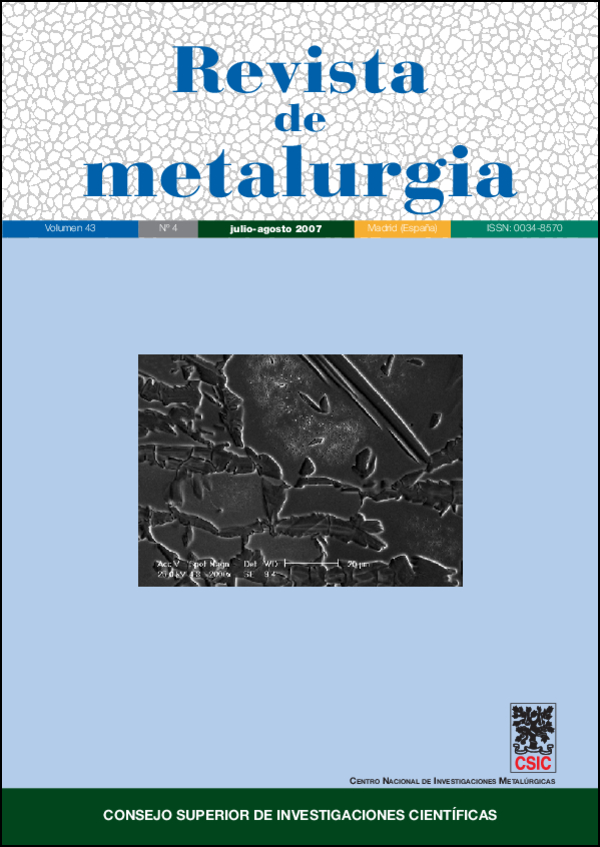High temperature fracture mechanisms on non-oriented electrical steels
DOI:
https://doi.org/10.3989/revmetalm.2007.v43.i4.72Keywords:
Hot ductility, Fracture mechanisms, AlN precipitationAbstract
In this research work the effect of deformation temperature on the hot ductility of non-oriented electrical steels (0.6 % Si-0.3 Al %) was studied using high temperature tensile tests. The specimens were machined from two thin slabs (50 mm thickness) produced by CSP process (Compact Strip Process), one of them using 100 % sponge iron and the other using 67 % scrap and 33 % sponge iron. The tensile tests were carried out at constant strain rate (5×1010–4 s–1), and a temperature range from 850 to 1,200 °C. The results showed that the ductility decreased with the increment in the temperature until approximately 1,000 °C. At higher temperatures, a ductility recovery was observed only in the steel fabricated without scrap. Scanning Electron Microscopy on fracture surfaces showed that the loss of ductility is associated with intergranular cracking promoted by the austenitic transformation and AlN grain boundaries precipitation.
Downloads
References
[1] B. Mintz, S. yue y J.J. Jonas, Int. Mater. Rev. 36 (1991) 187-217.
[2] J. Lewis, J. J. Jonas y B. Mintz, ISIJ Int.38 (1998) 300-308. doi:10.2355/isijinternational.38.300
[3] B. Mintz, ISIJ Int. 39 (1999) 833-855 doi:10.2355/isijinternational.39.833
[4] P, J. Wray, Metall. Trans. (1984) 2.059-2.073.
[5] E. Díaz, Tesis Centro de Investigación y Estudios Avanzados del IPN, (2006).
[6] J.H. Oh, S-H. Cho y J. J. Jonas, ISIJ Int. 41 (2001) 484-491. doi:10.2355/isijinternational.41.484
[7] B. Mintz, A. Tuling y A. Delgado, Mat. Sci. Technol. 19 (2003) 1.721-1.726.
[8] K. Ushioda, O. Akisue, K, Koyama y T. Hayashida, Developments in the Annealing of Sheet Steels, R. Pradhan and I. Gupta (Eds.), The minerals Metals and Materials Society, 1992, pp. 261-286.
[9] F.G. Wilson y T. Gladman, Int. Mat. Rev. 33 (1988) 221-286.
[10] S.F. Medina, M. Chapa, M. Gómez, A. Quispe y V. López y B. Fernández, Rev. Metal. Madrid 39 (2003) 408-417.
[11] A. Al Omar, A.Chenaoui, R. Dkiouak, J. M. Cabrera y J. M. Prado, Rev. Metal. Madrid 42 (2006) 103-113.
[12] J. Calvo, J. M. Cabrera y J. M. Prado, Rev. Metal. Madrid 42 (2006) 11-17.
[13] H. Matsuoka, K. Osawa, M. Ono y M. Ohmura, ISIJ Int. 37 (1997) 255-262. doi:10.2355/isijinternational.37.255
[14] O. Comineli, H. Luo, H.M. Liimatainen y L.P. Karjalainen, Rev. Metal. Madrid Vol. Extr. (2005) 407-411.
[15] B. Mintz, J.J. Jonas y S. Yue, Recrystallization ’90, T. Chandra (Ed.), The minerals, Metals and Materials Society, 1990, pp. 553-558.
[16] B. Dood y Y. Bai, Ductile fracture and Ductility, Academic Press, 1987, pp. 17.
Downloads
Published
How to Cite
Issue
Section
License
Copyright (c) 2007 Consejo Superior de Investigaciones Científicas (CSIC)

This work is licensed under a Creative Commons Attribution 4.0 International License.
© CSIC. Manuscripts published in both the printed and online versions of this Journal are the property of Consejo Superior de Investigaciones Científicas, and quoting this source is a requirement for any partial or full reproduction.
All contents of this electronic edition, except where otherwise noted, are distributed under a “Creative Commons Attribution 4.0 International” (CC BY 4.0) License. You may read the basic information and the legal text of the license. The indication of the CC BY 4.0 License must be expressly stated in this way when necessary.
Self-archiving in repositories, personal webpages or similar, of any version other than the published by the Editor, is not allowed.
















